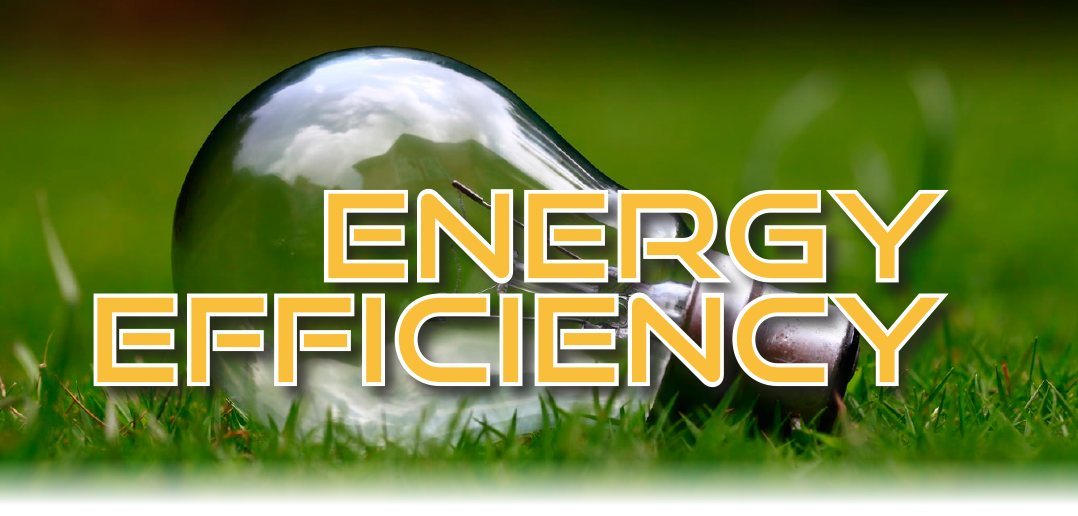There’s no question that Americans are hooked on practices that use a flabbergasting amount of energy every day. In fact, according to the U.S. Energy Information Administration (EIA), electricity accounted for 41% of household end-use energy consumption in 2019, while natural gas represented 44%, followed by liquefied petroleum gas, mostly propane. Space heating and air conditioning account for about 51% of annual seasonal household energy consumption, while water heating, lighting and refrigeration represent about 27% of total home energy use, and the remainder is used for things such as televisions, cooking appliances, washers and dryer, and electronics like computers, tablets, smartphones, video-game consoles, and internet streaming devices.
When it comes to commercial buildings—including offices, hospitals, food establishments, schools, police stations, churches, warehouses, hotels, and shopping malls—electricity and natural gas are the most common energy sources. Different commercial activities have unique energy needs but, as a whole, space heating accounts for about 25% of total energy use in commercial buildings, the EIA reports. Of commercial buildings, mercantile and service buildings use the most total energy. District energy services generally use fossil fuels, including coal, natural gas, or fuel oil, while some use renewable sources of energy like biomass, geothermal, solar, and wind energy.
Be it commercial or residential energy use, it’s important to educate ourselves about ways to save energy. Science is continuously delivering new technologies to professionals who can help make a difference, and we talked to some local experts to identify some of the tools at their disposal to improve energy efficiency.
Improving Your Perspective
An effective way to get a view of a commercial building’s energy efficiency is by getting up above them and using thermal imaging to identify weaknesses. Mirage Aerial Imaging (mirageaerial.com) does just that, providing baseline and post-damage structural assessments of commercial buildings—all via their from-the-sky view but controlled from the ground. Aerial thermal assessments improve energy efficiency in commercial buildings because they identify water infiltration beneath the surface of the roof. This is helpful because wet insulation is an energy drain.
“It is advised for the health of any low slope or flat commercial roof that you have a regular maintenance schedule consisting of visual inspections, cleanings, and regular Certified Roof Inspector visits,” said Tom vonAhlefeld, who owns the company with his wife, Sara. “An aerial thermal image provided by Mirage Aerial Imaging can assist in the inspection process by directing inspectors and building managers toward areas of potential water infiltration.”
Thermal scans show temperature differentiations and, if water potentially infiltrated a roof’s outer membrane, the underlying insulation would be wet. Wet insulation holds heat from the sun longer than dry insulation, allowing the thermal camera to “see” a temperature difference.
“The entire roof can be seen on one image and compared to a high-resolution photograph,” Tom said. “This helps increase safety, because there is no need for an inspector to take hours to walk the entire roof. A thermal scan allows for inspection of targeted areas on the roof but is controlled by people from the ground. We can also detect and confirm leaks early, decreasing overall maintenance costs due to unidentified leaks. Thermal imaging also potentially allows for targeted roof repair rather than replacement, and decreases energy costs.”
Streamline Your Way to Savings
The Streamline Energy Solutions (streamlineenergysolutions.com) team of energy-efficiency specialists operates with the goal of saving energy—and saving you money. They pride themselves on being a one-stop shop for all of your home energy-efficiency needs, providing various insulation and weatherization services, coupled with a crucial blower door test, to create immediate improvements in how your home uses energy.
“One of the biggest things we recommend to create the maximum impact when someone wants to insulate their home is to air seal it,” said Streamline Co-founder and BPI-Certified Auditor Jen Keller. “We’ll locate all the accessible crevices in your attic, including around your fixtures and top plates and seal them so to prevent conditioned air from leaking into the attic space. That preps the attic for us to insulate with blown-in fiberglass. We prefer this product over cellulose because it doesn’t settle over time, does not absorb moisture, and is a lot cleaner product. Of course, the baffles we install in an attic are a crucial step in the process, too, because they keep the insulation from blocking air flow through your soffit vents and provide necessary ventilation.”
Streamline uses CertainTeed Insulsafe SP blown-in insulation not only because it doesn’t settle but also because it provides better coverage, excellent sound control, lasts for the life of your home to reduce long-term energy demand and costs; is environmentally sustainable and formaldehyde-free; and comes with a limited lifetime warranty. This isn’t your typical itchy fiberglass. It is actually soft to the touch! Another fabulous offering from Streamline Energy Solutions that is not universal to all insulation companies is a blower door test because not everyone is BPI (Building Performance Institute)-certified to administer them. As a BPI-certified auditor, Jen starts by connecting the blower door device to one of the exterior doors of your home to audit energy loss.
Start Losing Power
Whether it is for the purpose of saving money, reducing emissions, or some other reason, commercial building managers are expected to develop long-term energy-reduction strategies. A new commercial building energy code, International Energy Conservation Code (IECC) 2018 went into effect in Nebraska in July 2020 and increases energy-efficiency requirements of new buildings substantially, so the task is truly at hand.
Energy Studio Inc. professionals have the expertise and technology to help commercial facility managers and developers create and realize an energy master plan to make their utility performance meet their long-term energy goals. They offer a wide array of services with a single focus: Improving the energy performance of commercial buildings. Among their services are an integrative design process; building-envelope optimization; energy modeling at all design phases; energy-code compliance; measurement and verification of energy performance; a lifecycle cost analysis; and energy audits. From a financial standpoint, however, will investments in energy efficiency pay for themselves in time?
“The right strategies do but the wrong strategies might not!” said Energy Studio Founder and President Amanda Bogner. “Every energy-efficiency strategy has its place in the market but may not be right for every building. Our lifecycle cost analysis is an important tool to evaluate how quickly a strategy will pay for itself. Understanding how a specific building uses energy is the first step to identify energy-efficiency strategies that may pay for themselves in time. For example, replacing windows in a medical building might not be the best use of capital funds. Energy consumption in a medical building is usually driven by conditioning fresh air. Window performance and wall/roof insulations contribute very little to improving this type of facility. Instead, design strategies focused on improving the efficiency of conditioning outdoor air should be prioritized.”
Amanda explained that understanding the utility rate structure is another important component for determining strategies that may pay a business back over time. For example, if a building is on a demand-based electric rate schedule, strategies that allow a building owner to control their peak demand may offer more savings than strategies that reduce overall electric consumption. Energy Studio can help you evaluate the history of your utility bills, which tell their trained professionals a lot about how you use your building and help identify no-cost or low-cost strategies you can deploy quickly to begin saving energy (and money) immediately. They can also help you create an energy master plan for your building or campus.
“Having a holistic energy strategy for your facility or campus can help crystalize where to spend precious capital,” Amanda said. Energy Studio professionals have the expertise and technology to help facility managers have confidence that their utility performance will meet long-term strategy goals.”
Insulating Your Investment
If you’re not building a new high-efficiency home or business, you can still make great strides in improving your building’s efficiency via some simpler, affordable options. Omaha Spray Foam (omahafoam.com) is a trusted and reliable insulation and roof-coating contractor in Omaha, who can help you achieve tremendous energy-efficiency improvements. Their professionals use the best products available in the market to provide homeowners with top-of-the-line services, including fiberglass insulation, spray-foam insulation, roof restoration coatings, cellulose insulation, hybrid insulation, sound-control insulation, insulation removal, and more.
“When you build or buy a home and skimp on insulation, you will notice that in your comfort and wallet,” said Brandon Lowndes, president of Omaha Spray Foam. “It’s what you can’t see that matters.”
Omaha Spray Foam will walk you through the range of options for spray foam, the most popular being wall insulation, attic insulation, crawl-space insulation, and floor insulation. R-values measures how well a building insulation can prevent the flow of heat into and out of your home, with higher R-values translating to greater insulation performance and, as a result, more savings on your upcoming heating and cooling bills. What sets Omaha Spray Foam apart from other companies are the relationships they establish with their clients. They understand the importance of communication and give no preference to any particular client or project, taking great pride in their ability to meet deadlines and their competitive prices and high-quality work.
It’s All About Balance
Back in the 1970s, the Western world experienced some serious energy shortages, among them the 1973 oil crisis and the 1979 energy crisis triggered by wartime interruptions in Middle Eastern oil exports. Electrical blackouts became commonplace, and it wasn’t long before people started to consider energy efficiency when designing and constructing their homes and commercial buildings. Strategies like passive solar energy and fewer windows were considered as Americans zeroed in on the wasteful ways they were using fossil fuels. Now, fast forward to 2020 where we find ourselves in the midst of a global pandemic where health and wellness are emerging at the forefront of the energy conversation. We are looking at a balancing act between innovation, risk, and the ability to keep people safe against germs and viruses in their schools, homes and businesses.
BranchPattern (branchpattern.com) is a commercial engineering and building consultancy firm in Omaha that is dedicated to creating Better Built Environments® through their many interwoven specialisms, including acoustics; audiovisual; security and telecom; building performance modeling; building enclosure analysis and design; total building commissioning; smart buildings, net-zero building performance; Mechanical, Electrical, Plumbing & Technology (MEPT) engineering, and more.
“We work to find building solutions that optimize energy, while placing a focus on people’s safety,” said BranchPattern Associate Principal Stuart Shell. “We help building owners and occupants to make those decisions with confidence. Even more so in light of the pandemic, businesses are getting ever-more-thoughtful about the air quality in their buildings.”
The focus on health is particularly poignant with COVID in mind, as businesses and individuals want assurance that their buildings are both energy efficient and have good indoor air quality, promoting health and wellness. To increase energy efficiency, buildings must have good insulation and a tight seal so that heated or cooled air is not lost through the windows, roof, or walls. Various strategies can be implemented to mechanical equipment which also reduces energy consumption. For example, energy recovery units or a well-tuned Building Automation System (BAS) could be used in a commercial building, while not new concepts, these are fitting for creating the intended balance between energy and health.
“We believe that when we design buildings, we need to think first about the people who are in them, creating human-centered designs,” Stuart said. “The mechanical equipment required to accomplish this is not new—but the demand for extremely healthy spaces with really good indoor air quality is even more prevalent today due to the coronavirus. For example, some school districts are bringing in more fresh air for students and faculty to breathe but are not paying the costs to reheat all that air because they are utilizing energy recovery generators. The whole point of reducing energy consumption is to protect our environment, as the way we currently make electricity pollutes the air and negatively impacts ecological well-being and human health. BranchPattern will continue to discuss this health-energy nexus as we design indoor environments that work for people and the planet.”
Safety, Comfort, and Energy Savings
In line with protecting both humans and energy supplies, equipment manufacturers are making a host of new products that can improve your home’s comfort AND help you operate it more efficiently. From the most state-of-the-art thermostats and zoning systems to whole-house air-cleaning, humidification, and dehumidification systems, security and video systems, the marketplace is geared to making homes more energy-efficient and secure. Engineered Controls (engineeredcontrols.com) is on the cutting edge when it comes to building systems that do it all.
“To combat indoor air problems, Engineered Controls offers demand control ventilation software that will automatically adjust heating and cooling systems to introduce higher levels of outdoor air only when occupancy levels of building contaminants are at a high level,” said Engineered Controls President and CEO Pat Killeen. “Equally important is that features like demand control ventilation only induce more outdoor air when required, thus allowing building owners to maintain optimum levels of IAQ (indoor air quality) and, at the same time, obtain substantial energy cost savings while increasing the comfort and productivity of the employees or tenants.”
Engineered Controls recently finished a $90 million expansion project at the Metropolitan Community College Fort Omaha campus, where they installed a Honeywell building management system that includes monitors and controls for all the traditional mechanical sub-systems like air-handling units, chillers, and pumps. In addition, the building automation system integrates electrical metering equipment, BTU metering, emergency generators, and lighting systems. Engineered Controls also featured custom energy or utility dashboards to assist students and faculty in visualizing energy consumption on campus, plus deliver weather data and energy-conservation suggestions about how to improve the building’s energy performance.
Regardless what you choose for your energy-efficiency upgrades, taking care of all of the systems in your home or business will determine how well they pay you—and the environment—back.
“Probably the most-overlooked and least-expensive way to save money on energy in your home or office is to maintain normal preventive maintenance on the mechanical and electrical equipment,” Pat reminded. “Engineered Controls offers our customers Planned Service Agreements, or PSA’s, to assist them in the daily operation of their facilities. The PSA has two elements—preventive care and routine maintenance—plus system-wide energy analysis.”
Style. Comfort. Efficiency.
The efficiency professionals at KPE Architecture – Engineering – Forensics (kpe-inc.com) are experienced at looking both at the big picture and the tiny details to help commercial-building owners create sensible environments that work as intended to create style, comfort, and efficiency. They address the unique needs of each building owner, while working within budget limitations and time constraints to transform ideas and concepts into comfortable spaces that incorporate efficient and economic construction practices. KPE engineers are also forensic engineering experts that use the lessons learned from investigating construction defects and the design errors of others to maximize the quality of KPE designs.
Some of the technologies that KPE clients are choosing for energy-efficiency include state-of-the art refrigerant flow, LED lighting, smart controllers, and solar tubes for water heating. In fact, KPE has pioneered a water-cooled variable refrigerant flow (VRF) system for cold climates like Nebraska. Demand for these efficient heating, ventilating, and cooling systems in the Omaha region is strong, and they yield tax credits and utility-company incentives.
“For businesses, VRF fan terminal units are connected to either water or air-cooled condensers with refrigerant lines, and they provide both heating and cooling simultaneously,” said Brad Lauritsen, associate principal and mechanical engineer. “It eliminates messy ductwork and pipes, as well as water leaks. Safe 401A refrigerant is generally used in these systems as it is not so detrimental to the environment as other refrigerants. When coupled to a geo-exchange wellfield, you have access to tax credits and the most energy-efficient system available. VRF is an excellent choice for an older building, where running ductwork and pipe is difficult.”
Some of the biggest culprits of energy loss are in old buildings with single-pane windows or windows that aren’t thermally broken, as well as poor insulation in attic spaces, and definitely any building still using a steam heating system.
“A steam system is very inefficient,” Brad said. “We design projects to convert from steam to hot-water heating, or some other more efficient system. The economy is changing to a natural-gas economy because the U.S. has ample amounts of this clean energy source.”
Attaining responsible energy efficiency in our homes and buildings is something to which each of us can contribute. Reach out to our local professionals who can help you do your part, attaining a balance between sustainability and your personal health and comfort.








